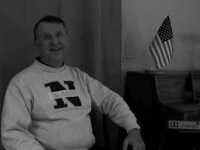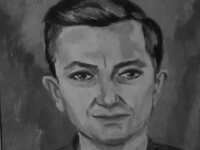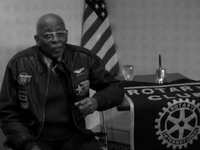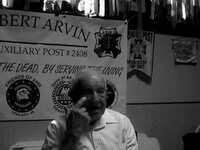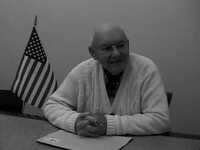Search
113 items
-
Mr. Hill attended Officer Candidate School in Newport, Rhode Island, and was commissioned as a Lieutenant in the United States Navy. Being trained as a naval scuba diver and in explosives, Mr. Hill was assigned to a naval base with nuclear facilities in Newfoundland, Canada. Considered an active duty assignment, Mr. Hill would go on to serve in Iceland, and later as an evaluator of officer candidates in Washington, D.C. Mr. Hill is quoted in the interview as being a big fan of the Navy football team. He would serve in his evaluation of officer candidates until 1968.
-
Oscar Hong enlisted in the Army in 1943, at the age of 19. A friend told him that the Army was looking for interpreters, while Oscar was in New York City. He was sent to Miami for his basic training, and then to Springfield, Illinois, for his Signal Corp training. From there he went to Greely, Colorado and eventually to Burma. Oscar's job was to be an interpreter, primarily for the American Services, in the Flying Tigers group. Although he did not fly on any missions, he described the many bombing raids by the Japanese. He said it was boring in between the raids. After the end of the War, he was discharged. Oscar and his family built a very successful restaurant business in the Detroit area. After his wife died, he sold the business and retired. He eventually moved into his daughter's home, but is now living in a retirement complex, in Ann Arbor. Oscar's decorations include a Good Conduct Medal and a China/Burma/India Theater Medal.
-
George S. Hunt was drafted into the Air Force. George entered the service at a time when the United States was very short on flying personnel. After an accelerated training program, George was sent to England. George and his crew flew several difficult missions. One involved a crash landing in England. When George was finally shot down, his plane was shot up so badly that the crew jumped out. George was captured and taken to a stalag, where he spent 14 months. Upon his discharge, George entered college and received his PhD from the University of Michigan in Wildlife. George became a Professor of Natural Resources and taught about birds, trees, and nature until his death in 1971. His history and experiences were relayed by his widow, Virginia Hunt. Although he lived only until the age of 51, he touched many lives and carried a message of being careful of our environment, and of making our land better for future generations.
-
Ed Huse enlisted in the Navy Air Corps at the age of 22, after his third year in college. He took his basic training in California, and his pilot training in Arizona. He took to flying immediately, and commented "I did it very well!" As soon as he learned to land on aircraft carriers, he was assigned to the Monterey. He saw action in Saipan, Tinian, and the Philippines, flying a Grumman Hellcat. Ed described a situation in which he could not get both landing gears down. Therefore, he was directed to land on an island. When he got there, he still could not release his gear, and landed with some difficulty. Although Ed did not receive any individual medals, he did receive a number of Battle Stars. After being discharged, he went into advertising and promotion, at which he felt he would be good, and he was. Ed completed his BA in eight years, going to Wayne State University part time. He had three children, losing his son, who was also a Navy man. Ed was even mugged and had $1,500 stolen. Ed divorced his first wife after 28 years. He now lives with his second wife at Gilbert Residence, in Ypsilanti, Michigan.
-
Robert was inducted on February 8, 1944, after completing one year at the University of Michigan School of Engineering. He had been deferred once, but turned down a second deferment, because he wanted to be part of the war effort. Robert started out in the ASTP program which made him happy, because he thought that he could continue his education. After two weeks, he was headed for basic training at Fort Benning, Georgia, and was assigned to the 95th Infantry Division. The 95th was used as a replacement pool for other Divisions that had experienced large numbers of casualties. On August 9, 1944 Robert embarked for Liverpool on an unescorted ship, the USS West Point. Fortunately, the ship was too fast for the U-Boats. After three weeks in England, the 95th was sent to Omaha Beach, where it joined the 3rd Army under General George Patton. Robert’s outfit captured the major city of Metz, taking major casualties. He was then transferred to the 9th Army for the drive on the Rhine River. Although the worst fighting was over, "mopping up" operations took many lives. Robert returned to the United States for a thirty-day furlough, prior to being sent to amphibious training, for the planned invasion of Japan "Operation Coronet." The planned invasion was cancelled after the Japanese surrender. Of the original 44 men in his platoon, he was one of six who came through uninjured. Robert experienced the fear of combat, and he wondered if he would make it to see his parents again. Although not wounded, he did spend 27 months in hospitals because of service-connected TB. With service time, hospitalizations, and reduced workloads, it took Robert ten years to finish college. The 95th has had reunions since 1950, being deactivated right after the War, with diminishing numbers. Last year alone 99 members died. The morality of using the "bomb" stirred up much controversy, but Robert firmly believes that without it, he wouldn't be here today.
-
After the United States entered World War II, Paul Jankoviak received deferments from the draft, because he held an essential job. He felt guilty about this and forced the Draft Board to take him. Soon after he entered military service, he volunteered for the paratroopers, and was shipped to Europe. Paul's Unit jumped into battle during Operation Market Garden from 500 feet. More than 500 planes participated, and Paul witnessed gliders crashing with men still inside them. After 85 days of continuous battles, his unit was transferred to the Battle of the Bulge. They were warned that the Germans were not taking prisoners, but Paul was captured. He was put on a truck that had American markings. German planes shot up the truck even though the people inside were being transported as prisoners. Paul received frequent beatings from the Germans. When he was finally released, the doctor told him he was one or two days from dying. He spent 6 months in hospitals. After his discharge, Paul took a job as a tool and die Maker. He is proudest of the fact that he built his own house and didn't borrow any money for it. Now retired, Paul lives in Lansing, Michigan. He has 6 children and 13 grandchildren.
-
After earning a Bachelor of Science degree from Clark College in Atlanta, Georgia, and completing several courses of graduate work in Chemistry at Howard University, in Washington, D.C., Mr. Jefferson graduated from pilot training school at Tuskegee Army Airfield in January 1944. Piloting a P-51 fighter plane with the distinctive red tail of the Tuskegee Airmen, Mr. Jefferson was shot down by German forces in August of 1944. Jefferson was a POW at several German installations until his liberation in April of 1945. After his discharge from the Army Air Corps in 1947, Mr. Jefferson would work as science teacher and later assistant principal in the city of Detroit. Due to his service as a Tuskegee Airman and his involvement in the community, Mr. Jefferson was awarded a member of the Michigan Aviation Hall of Fame.
-
Gene enlisted in the Navy in 1940, at the age of 19. Living in Tennessee at the time, he was sent first to Knoxville, and then onto Norfolk, Virginia, for his basic training. He was eventually transported to Pearl Harbor in Honolulu, Hawaii, via an oil tanker, where he was assigned to the battleship West Virginia in September 1940. The West Virginia was hit several times during the bombing of Pearl Harbor, which led to its eventual sinking. When the opportunity arrived, Gene signed up for duty on the Lexington – however, it too was sunk in the Coral Sea, just weeks before the battle of Midway. He was transferred back to Norfolk, Virginia, where he was assigned to the Thomas Stone, a troop transport. Gene was transferred once again, this time to the North African Naval Headquarters, in Algiers. After the Germans were forced out of North Africa, his entire unit was transferred to Naples, Italy, where once again he worked for the transportation department. After his leave, he was assigned to the U.S.S. Columbus, where he served through the end of the war, until his enlistment was up in 1946. After leaving the Navy, Gene returned to Knoxville, Tennessee. His search for a better job brought him to Michigan in 1948, where he first worked for Packard. He then moved to Ypsilanti, where he worked at Kaiser-Frasier until it closed. Gene quickly got another job at Ford Motor Company’s Ypsilanti plant, where he worked for 30 years, until his retirement in 1982.
-
When Harry Kaczorowski was interviewed, he was 88 years old, a veteran of World War II and a POW of the same. Although his memory was a little sketchy, his daughter, Toni Oliveri, was able to supplement his memory. Harry was captured shortly after landing in North Africa. He spent 27 months in various prison camps. His memory focused on working on farms, and he said that he had enough food throughout his interment. Toni reminded him that while he was being interrogated, the Germans broke his collarbone and arm. As the war was winding down, the Germans continually moved prisoners, by foot, over a "600-mile death march." It was so cold that prisoners would wake up each other every 10 minutes, or they would freeze to death. Prior to being taken prisoner, Harry was on guard duty at the Allied Headquarters in Algiers. He irritated one General because he would not allow him to pass, since he did not recognize him. That General was George Patton.
-
Marvin was drafted before he finished high school. After completing basic training in Illinois and Wyoming, he was sent to England on a converted liner. Some 8,000 GIs were on this ship, staked five high in bunks. Marvin was in the middle bunk. He stated that being with so many sick soldiers and in the middle bunk was quite the experience. In England, he was assigned to waterproofing supplies that were headed for Omaha Beach. Marvin remained in England until VE Day. While there, he was involved in guarding Polish prisoners of war, most of whom had been forced into service in the German Army. Eventually, Marvin was part of the Occupation Army in Germany. He was fortunate to get a pass to the Palace of Justice and witnessed Herman Gering's trial. After leaving the service, Marvin returned to Rogers City, where he began his career as a seaman on the Great Lakes, eventually working himself up to the rank of Master Captain. He retired after 32 years of sailing.
-
While enrolled as an undergraduate at the Michigan State Normal School (now Eastern Michigan University) in Ypsilanti, Michigan, Mr. Kettles was drafted into the United States Army in October of 1951. Commissioned as a Lieutenant after completing Army Flight School in 1953, Mr. Kettles was sent to Korea, but only after the conflict had ended. After returning to the United States, Kettles served in the Army Reserve until he volunteered for active duty service in Vietnam in 1963. In May of 1967, Kettles was directly responsible for saving the lives of 44 American soldiers who were ambushed by North Vietnamese forces. Serving a second tour of duty in 1969, Mr. Kettles returned to United States in 1970 to work with combat readiness for Army Reserve and National Guard units in Texas. Mr. Kettles was discharged from the U.S. Army in 1978, and went on to finish his degree at what was then Eastern Michigan University. Completing a master's degree at Eastern Michigan University a short time later, Kettles would come to teach at Eastern Michigan University himself and was the force behind the schools Aviation Management program. In 2016, Charles Seymour Kettles was awarded the Medal of Honor by President Barack Obama for his heroism in saving the lives of those 44 service members in May of 1967.
-
Owen enlisted in the Marine Corps, in January 1943, because he did not want to be drafted into the army. Joining him were three friends, who all wanted to serve together. The Marines could not guarantee this, and as it turned out, each one went into a different service (Army, Navy, Army Air Force, and Marines). After enlisting, Owen took the train to San Diego for boot camp, in May 1943. He was shipped out in February, 1944, to the Marshall Islands with the 2nd battalion, 4th marine division. His company was a “joint assault signal company” that was responsible for ship-to-shore communications. He was a telephone man, who carried the wire and switchboard to set up these points, mainly for the command posts. Though radio was more widely used, the telephone was also a way in which personnel communicated between posts or ship-to-shore. One problem that service members encountered often was that their own tanks would run over and damage previously laid wire. Owen was generally on the front lines in the command post. He often laid line and operated the switchboard during combat, including combat that involved machine gun fire. One thing that he remembers the most was when he landed on the beach in 1944 next to a marine, and as he turned to ask if he was ok, he noticed the man had been decapitated. That experience drove home the reality of war. Just after that, one of the American block houses blew up, and Owen was hit by burning shrapnel, so he was taken to the medical tent. There, he was bandaged, but he refused a purple heart because the man next to him had lost a leg, and Owen didn’t think it was fair to receive an award for his own small injury, in comparison to the other soldier. He landed at night on the island of Tinian, to set up a command post. He was on switchboard duty one night until 2:00, when he was relieved. He and two others dug a foxhole to sleep in. Within five minutes of the foxhole’s completion, an artillery shell hit the tree near them. The other two men were hit, and one was killed. The man that had taken Owen’s place at the switchboard had been killed as well. The tarp was only free of scarring where the man had been laying. Owen received a Presidential Unit Citation when the 4th division took Saipan. This unit would also later take Iwo Jima, but by that time he was in the hospital. In August 1944, he became ill, and went to army hospital. Owen had Ludwig’s Angina; an inflammation of the right mandible joint. He had to have a tracheotomy, and was in the hospital from October through March, during which time he had 144 shots of penicillin. Owen then went back to the rest camp on Maui. When he came back, he and others began training for the intended invasion of Japan. The plan was to land on the first Japanese island in March 1946. The plan was cancelled after the Japanese surrender. He returned in October and was discharged on November 19th 1945. After his discharge, Owen stayed with his mother. He met a girl in 1942, prior to his service, who worked in a restaurant on State Street in Ann Arbor. They wrote to each other during the war, and she was proud that he went. They got married in 1947, had 11 children together, and are still married today. Owen worked at an optical business after the war. He started as a messenger boy delivering glasses. Owen would later open his own business, called Quarry Optical, which later became Richardson’s optical. He sold the business in 1990, and retired. Owen believes that “once a marine, always a marine”, and is a member of the Marine Corps League of Washtenaw County.

